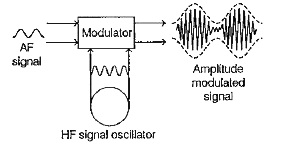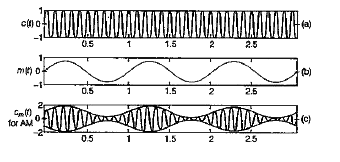What is modulation? Draw a diagram of modulated signal. Name the types of modulation and define frequency spectrum in AM and give graphical representation with modulation index.
Text Solution
Modulation It is the process of translating a low frequency intelligent signal into a high frequency signal suitable for transmission through available channel without much attenuation. This is done by superimposing LF information over a high frequency carrier signal.

Types of Modulation Consider a carrier wave represented by c(t)=Acsin(ωct+ϕ)
where, c(t) = signal strength of carrier wave,
Ac = amplitude of carrier wave,
ωc = angular frequency
and ϕ = initial phase of the carrier wave.
Corresponding to the three variables Ac,ωcandϕ, we can have three different types of modulation which are given below:
(i) Amplitude Modulation (AM)
(ii) Frequency Modulation (FM)
(iii) Phase Modulation (PM)
Frequency Spectrum in AM The modulated signal now consists of the carrier wave of frequency ωc and two sinusoidal waves each with a slightly different frequency, known as side bands.
The frequency spectrum of the amplitude modulated signal is shown below:

Upper Side Band (USB) frequency
=fc+fm=ωc+ωm
Lower Side Band (LSB) frequency
=fc−fm=ωc−ωm
where, fcandfm are frequencies of carrier wave and modulating wave, respectively.
Bandwidth = USB - LSB = (fc+fm)−(fc−fm)
=2fm=2ωm
The spread of frequency from one end to the other end is called bandwidth.
Graphical Representation
Graphical representation of amplitude modulation is shown as below :

Modulation Index The modulation index is defined as the ratio of change in the amplitude of modulated carrier wave (Am) to the amplitude of unmodulated carrier wave (Ac).
i.e. μ=AmAc=Amax−AminAmax+Amin
where, Amax = maximum amplitude of AM wave
and Amin = minimum amplitude of AM wave.
|
Similar Questions
Knowledge Check
What is the modulation index of an over modulated wave
A1BzeroC<1D>1If Am and Acare the amplitudes of modulating signal and carrier wave respectively, then modulation index is given by
Aμ=AmAcBμ=AcAmCμ=A2cAmDμ=A2mAcCalculate modulation index if carrier waves is modulated by three signals with modulation indices as 0.6, 0.3 and 0.4
A1.0B0.70C0.78D1.3
What is meant by term 'modulation' ? Draw a block diagram of a simple modulator for obtaining an AM signal.
View Solution(a) What is amplitude modulation? Draw a diagram showing an amplitude modulated wave obtained by modulation of a carrier sinusoidal wave on a modulating signal.
(b) Define the terms (i) modulation index, and (ii) side bands. Mention the significance of side bands.
View SolutionModulation index in FM signal
View SolutionDefine frequency modulation and state any one advantage of frequency modulation (FM) over amplitude modulation (AM).
View SolutionIf Am and Acare the amplitudes of modulating signal and carrier wave respectively, then modulation index is given by
View Solution
